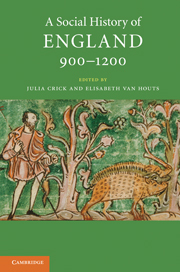Book contents
- Frontmatter
- Contents
- List of figures
- List of maps and tables
- List of contributors
- Acknowledgements
- List of abbreviations
- Map 1 England and its neighbours
- Map 2 England 900–1200
- I Introduction
- I.1 Land use and people
- I.2 Water and land
- I.3 Forest and upland
- I.4 Mineral resources
- I.5 Health and disease
- II.1 Authority and community
- II.2 Lordship and labour
- II.3 Order and justice
- II.4 War and violence
- II.5 Family, marriage, kinship
- II.6 Poor and powerless
- III.1 Towns and their hinterlands
- III.2 Commerce and markets
- III.3 Urban planning
- III.4 Urban populations and associations
- IV.1 Invasion and migration
- IV.2 Ethnicity and acculturation
- IV.3 Intermarriage
- IV.4 The Jews
- V.1 Religion and belief
- V.2 Rites of passage and pastoral care
- V.3 Saints and cults
- V.4 Public spectacle
- V.5 Textual communities (Latin)
- V.6 Textual communities (vernacular)
- VI.1 Learning and training
- VI.2 Information and its retrieval
- VI.3 Esoteric knowledge
- VI.4 Medical practice and theory
- VI.5 Subversion
- Glossary
- Time line 900–1200
- Further reading
- Index
- References
IV.1 - Invasion and migration
Published online by Cambridge University Press: 05 June 2012
- Frontmatter
- Contents
- List of figures
- List of maps and tables
- List of contributors
- Acknowledgements
- List of abbreviations
- Map 1 England and its neighbours
- Map 2 England 900–1200
- I Introduction
- I.1 Land use and people
- I.2 Water and land
- I.3 Forest and upland
- I.4 Mineral resources
- I.5 Health and disease
- II.1 Authority and community
- II.2 Lordship and labour
- II.3 Order and justice
- II.4 War and violence
- II.5 Family, marriage, kinship
- II.6 Poor and powerless
- III.1 Towns and their hinterlands
- III.2 Commerce and markets
- III.3 Urban planning
- III.4 Urban populations and associations
- IV.1 Invasion and migration
- IV.2 Ethnicity and acculturation
- IV.3 Intermarriage
- IV.4 The Jews
- V.1 Religion and belief
- V.2 Rites of passage and pastoral care
- V.3 Saints and cults
- V.4 Public spectacle
- V.5 Textual communities (Latin)
- V.6 Textual communities (vernacular)
- VI.1 Learning and training
- VI.2 Information and its retrieval
- VI.3 Esoteric knowledge
- VI.4 Medical practice and theory
- VI.5 Subversion
- Glossary
- Time line 900–1200
- Further reading
- Index
- References
Summary
Looking back to the year 1000, the mid-twelfth-century historian Henry of Huntingdon characterized the coming of the Danes and the Normans as a divine punishment for the English comparable with the Britons' fate after the invasions by the Angles, Saxons and Jutes:
This He brought about as if laying a military ambush. I mean that on one side the persecution by the Danes was raging, and on the other the connection with the Normans was growing, so that even if they were to escape the obvious lightning fire of the Danes, valour would not help them to escape the Normans' unexpected trick.
This retrospective view by the bilingual married archdeacon, son of a Norman clerk and an English mother, whose job required him to travel around in the Danelaw, is a valuable starting point for the present chapter. Between 900 and 1200 England experienced repeated foreign invasion, culminating in three periods of extended rule. While the first resulted in settlement and occupation of much of northeast England in the late ninth and early tenth century, the latter were political takeovers by a military elite which turned the eleventh century into an era of unprecedented trauma in the history of the English people. In this chapter the elite small-scale immigration will take centre stage with subsidiary roles for the various groups of immigrants that entered the country as they have done throughout English history (mercenaries and merchants, artisans and craftsmen as well as clerks and clergy).
- Type
- Chapter
- Information
- A Social History of England, 900–1200 , pp. 208 - 234Publisher: Cambridge University PressPrint publication year: 2011
References
- 2
- Cited by

